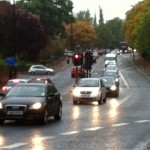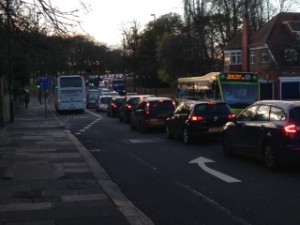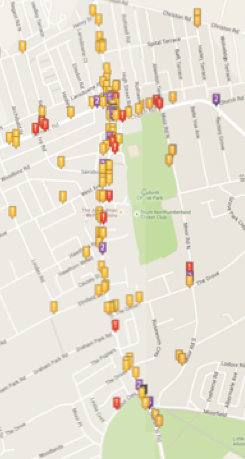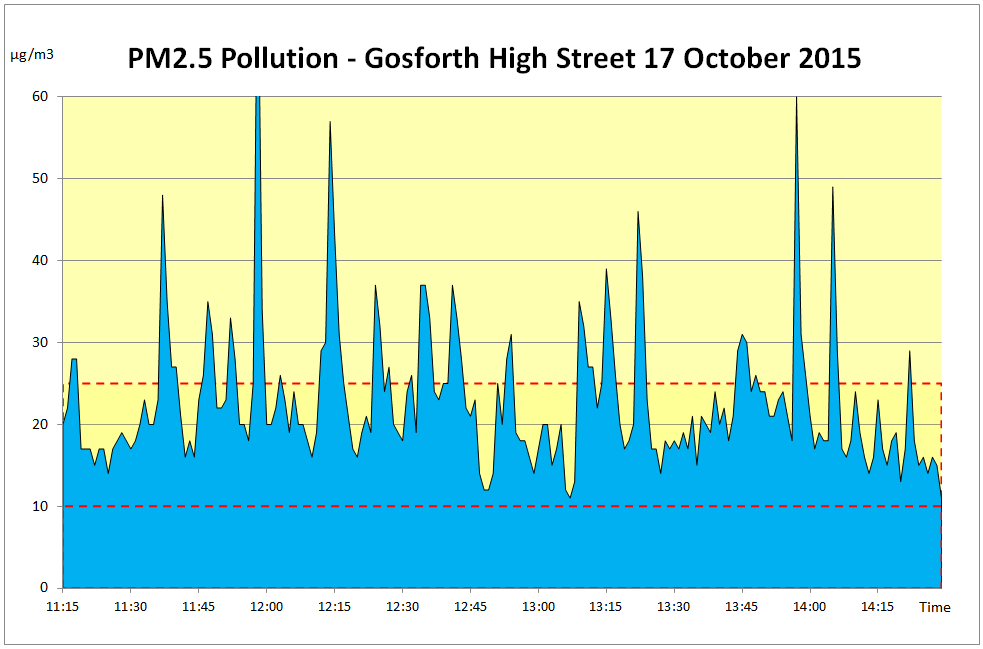We are all familiar with thinking about the environmental and health aspects of traffic – congestion, pollution, greenhouse gas emissions, noise, accidents, physical inactivity – but what about the economics, the actual costs of these things in pounds? And how do these negative impacts affect Gosforth High Street, as these are the issues that the soon-to-be-announced proposals for the High Street need to fix?
In 2009 the UK government calculated the negative impact of transport on the UK economy to be between £38.1 and £48.7 billion each year. With price inflation, growth in traffic volumes and a better understanding of the damage caused by pollution, the cost for 2016 could be much higher still.
The graph below shows the cost of each of the negative impacts of transport, with the light blue indicating the likely maximum and minimum costs:
Source: The wider costs of transport in English urban areas in 2009, Cabinet Office Strategy Unity. Also reported in Air Pollution: Action in a Changing Climate, Defra, 2010
On Gosforth High Street:
1. Excess Delays
Gosforth High Street – October 2015
Congestion might be less of a concern than preventing accidents or the health impacts of pollution, but no-one can deny that it affects Gosforth High Street. You can see this most mornings and afternoons throughout the year.
The traditional response to congestion has been to increase road capacity, for example by adding extra road lanes. In theory, more capacity should lead to a greater throughput and less waiting, but in practice the extra capacity attracts more traffic in an effect called induced traffic. This negates a large part of the expected benefit while also creating more pollution and traffic danger.
The opposite effect, called disappearing traffic, also exists. An analysis of this effect published in Municipal Engineer – Disappearing traffic? The story so far – concludes that:
“Reallocating road space from general traffic, to improve conditions for pedestrians or cyclists or buses …, is often predicted to cause major traffic problems on neighbouring streets. … Predictions of traffic problems are often unnecessarily alarmist, … Significant reductions in overall traffic levels can occur, with people making a far wider range of behavioural responses than has traditionally been assumed.”
This analysis suggests that life goes on – congestion does not get worse. As a result the whole area benefits from better air quality and safer streets.
2. Accidents
Any calculation of the cost of road casualties assume that the value of life and health can be quantified, and that deaths and/or injuries should be accepted in order to facilitate the movement of traffic. This need not be so.
Vision Zero is a multi-national road safety project that targets zero deaths and zero serious injuries in road traffic. It takes the opposing view that
“Traffic deaths and injuries are preventable; therefore, none are acceptable”
and that
“Human life and health are paramount and take priority over mobility and other objectives of the road traffic system“.
SPACE for Gosforth would like to see this principle applied to Gosforth High Street.
This map from www.crashmap.co.uk shows road traffic crashes on and around Gosforth High Street from 2005 to 2014. Only crashes reported to the police which have one or more recorded casualties are shown.
Orange tags denote slight injuries, red tags are for serious injuries and the black tag shows a fatality. Purple tags show clusters where there have been multiple crashes.
[Source: www.crashmap.co.uk ]
Clearly Gosforth High Street does not meet Vision Zero standards.
Vision Zero also assumes that mistakes are inevitable, so roads should be designed to minimise injury to the people that use them, rather than relying on road users to always avoid mistakes. In Gosforth, “road users” could include a middle school pupil having to cross a busy road on the way to school, or an 11-year old on a bicycle (as UK law requires 11 year-olds to ride on the road).
The two main ways of minimising injury are
- reducing traffic speed to 20mph. At 20mph a pedestrian would have approximately a 90% chance of surviving a collision; and
- providing separation on faster roads, roads with a high volume of traffic, or roads used by larger vehicles such as buses or lorries. Separation in this context might include protected cycle lanes or signalised pedestrian crossings.
See also the SPACE for Gosforth posts 20 mph – the right speed for Gosforth’s children and Lots of children want to cycle to school, but hardly any do.
3. Poor Air Quality
SPACE for Gosforth monitored the air pollution on Gosforth High Street last year. This graph shows the results:
Source: SPACE for Gosforth, 2015
To put our findings into context, a report on cognitive decline in older people concludes that
“people living in high pollution areas, with 15 micrograms per cubic meter or more of PM2.5 had error scores one and a half times those of the participants who lived in low pollution areas with no more than 5 micrograms per cubic meter.”
The reading cited in that report (15 µg/m3) is less than the average reading for our monitoring on Gosforth High Street: that was 23 micrograms per cubic meter.
Other health effects of pollution are widely documented, including in this SPACE for Gosforth post.
We listed ways to reduce pollution in our article Fixing Pollution on Gosforth High Street, including encouraging the use of public transport or walking or cycling.
4. Physical Inactivity
According to the report Turning the Tide of Inactivity by UK Active over a quarter of Newcastle residents are classed as inactive – doing less than 30 minutes of moderate physical activity per week. Activities could include walking, cycling, playing sport, gardening or dancing. The consequence of this inactivity is reported to be 279 premature deaths and a cost of £16.8m each year for Newcastle alone.
Making our streets safer for walking and cycling helps people be active in their every-day lives. Even a short walk to buy a pint of milk could make a big difference to someone’s health.
5. Greenhouse Gas Emissions
We don’t have figures from Gosforth High Street but this graph shows the Europe-wide change in transport-related emissions since 1990.
Source: European Commission – Climate Action
This is what the associated report has to say about greenhouse gas emissions:
“Road transport alone contributes about one-fifth of the EU’s total emissions of carbon dioxide (CO2), the main greenhouse gas. While emissions from other sectors are generally falling, those from transport have continued to increase until 2008 when transport emissions started to decrease on the back of higher oil prices, increased efficiency of passenger cars and slower growth in mobility.”
“Despite this trend transport emissions were in 2012 still 20.5 % above 1990 levels and would need to fall by 67 % by 2050 in order to meet the 2011 Transport White Paper target reduction of 60% compared to 1990.”
Not all journeys can be made using public transport or on foot or by bike, but at present many people are deterred from walking and cycling because they do not find it safe or pleasant. Making it easier and safer to do so will allow people to make choices that suit their lifestyle. That will also help reduce greenhouse gas emissions.
6. Noise – amenity
Gosforth High Street is undoubtedly noisy. We discovered this when we spent a Saturday morning measuring pollution levels, and talked to shoppers over the sound of the traffic. We don’t have any measurements but we do know the effects can be far more serious than you might expect.
In one study we found, researchers discovered that:
“exposure to the sounds of car traffic significantly increases the risk of heart attack in people over 50. For every 10 decibels of increase in traffic noise, the risk of heart attacks rises 12 percent.”
Another study found that:
“people living in areas with high traffic noise were 25 percent more likely than those in quieter neighborhoods to have symptoms of depression, even when adjusting for socioeconomic factors.”
If you own or have access to a noise monitor we would love to hear from you!
Join us to campaign for safer streets, cleaner air, quieter neighbourhoods and a better environment
These are improvements we all want. The proposed changes to Gosforth High Street are a once in a generation chance to make this happen in Gosforth, and a strong response from residents is important to ensure that the proposed plans will minimise these issues.
To find out more, get involved and be kept up to date on issues and initiatives in Gosforth you can join SPACE for Gosforth here.








I live near Ashburton Road in Gosforth. Sometimes when I open the front door in the evening to put the milk bottles out, I can actually smell chemicals in the air, a sort of horrible acrid smell. It is particularly noticeable if there is low cloud. It may be that I have a particularly good sense of smell because other people I have spoken to don’t seem to be aware of it. It’s quite worrying to think there is this invisible pollution in the upper atmosphere. How much is Gosforth affected by say Gateshead industries and car use blowing over here? I had never thought about it before!
Extract from a study on the effects of transport noise 21 July 2017.
https://scienmag.com/transportation-noise-increases-risk-for-cardiovascular-diseases-and-diabetes/
Increased risk for developing cardiovascular diseases
The results published so far show that aircraft, rail and road traffic noise in Switzerland leads to adverse health effects. For cardiovascular disease mortality, the most distinct association was found for road noise. The risk of dying of a myocardial infarction increases by 4 per cent per 10 decibel increase in road noise at home. Also the risk of hypertension and heart failure increases with transportation noise. “Particularly critical are most likely noise events at night regularly disturbing sleep,” says Martin Röösli, principal investigator of SiRENE and professor of environmental epidemiology at Swiss TPH and the University of Basel. “The threshold for negative health impact is lower than previously suspected.”
Noise also favours Diabetes
In addition to cardiovascular diseases, transportation noise also increases the risk of developing diabetes. This is shown by an examination of 2,631 people exposed to different degrees of noise pollution. “Two mechanisms play a role,” explains Nicole Probst-Hensch, Head of the Department of Epidemiology and Public Health at Swiss TPH. “On the one hand, the chronic release of stress hormones influences insulin metabolism. On the other hand, sleep problems are known to negatively affect metabolism in the long term.”
Article about road traffic noise from the Guardian 3/7/2018
Sonic doom: how noise pollution kills thousands each year.
“From heart disease to type 2 diabetes, noise is having dire effects on people’s health. So who is most at risk, what can be done about it – and can you protect yourself?”
https://www.theguardian.com/lifeandstyle/2018/jul/03/sonic-doom-noise-pollution-kills-heart-disease-diabetes
Article about fuel duty from the Guardian 3/7/2018
May close to lifting fuel duty freeze to help meet NHS promises
“while motorists have saved hundreds of millions of pounds over the last eight years, the successive freezes are estimated to have cost the Treasury around £46bn since 2011-12, with further losses of £26bn to be incurred by the end of 2020-21. … former government transport advisor Professor David Begg claimed that freezing duty had reduced fuel prices by 13%, resulting in a 4% increase in traffic that had triggered 4.5m tonnes of carbon dioxide”
https://www.theguardian.com/politics/2018/jul/02/freeze-on-fuel-duty-may-be-lifted-to-help-meet-nhs-promises
Article from Treehugger.com
What Is the True Cost of Car Ownership?
https://www.treehugger.com/what-is-true-cost-of-car-ownership-5095664